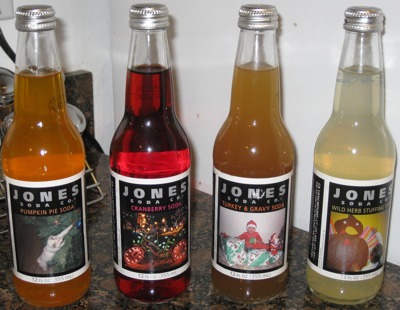In the interest of using the internet to facilitate original scientific research, I am publishing the results of my inadvertent experiment regarding the relative freezing points of various novelty sodas.

Revenge of the White Elephant
At a white elephant gift exchange a few years ago, I received a re-gifted set of novelty holiday-themed sodas created by the Jones Soda Company. They created several of these over the years. This one had pumpkin pie, cranberry, wild herb stuffing, turkey and gravy, and — sigh — Brussels sprout flavors. I never got around (or got up the courage) to sample them and they have languished in my bachelor refrigerator ever since. The reason for the “bachelor” qualifier is that it stays fairly empty and I generally keep a pretty good mental inventory of its contents. Imagine my surprise when I noticed a strange, light green liquid on the bottom.
It smelled strange but I figured it was coming from a plastic container containing a friend’s homemade pickles. I removed the pickles from the equation and cleaned up the liquid. Later on, I noticed some more liquid had collected. The inside bulb is burned out (remember, bachelor fridge) so it’s a bit dark inside. However, I eventually spied a shard of clear glass.

Results
So it seems that the Brussels sprout soda had frozen and expanded until the glass bottle could no longer contain the block. That explains the sound of crashing glass I recall hearing the night before which emanated in the general vicinity of the kitchen.
The bottle was in pretty bad shape but much of the soda was still frozen inside what remained of the bottle. That it must have been gradually melting explains why there was more fluid sometime after the initial cleanup. I immediately, but gingerly, removed the other 4 bottles for fear that they might be ready to burst as well. But none of the 4 showed any sign of freezing.
What to conclude? Either the brussels sprout soda has a significantly higher freezing point than the other 4 flavors and was adversely affected during a freak temperature drop; or the Brussels sprout soda was situated in a colder section of the refrigerator. It’s also possible that all of them were affected by the temperature event but the others didn’t make it to the breaking point before the event reversed.
Impact
I can theorize about it all day. But in the end, I need to clean it up. How does this pertain to multimedia hacking? Well, I was going to add long-overdue test cases to FATE tonight, but that may have to wait. Fortunately, I was at the end of a shopping cycle and all I had to toss were some soda-saturated bananas. I’m keeping the butter since I don’t think it was affected, much. To any coworkers reading: if my cookies taste vaguely of Brussels sprouts over the next month, then, well… I happen to know that’s the closest some of you will come to consuming a vegetable all month.
And I never got to taste the Brussels sprout soda. Actually, that’s the part about this episode that bothers me the least.
